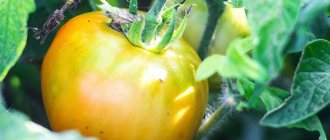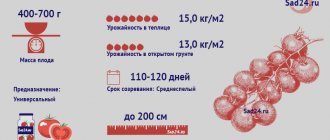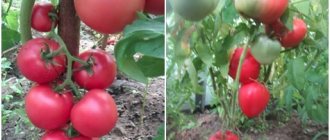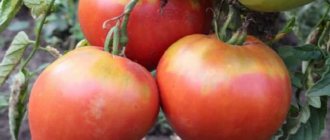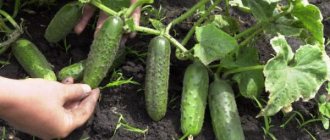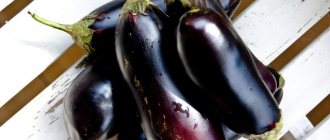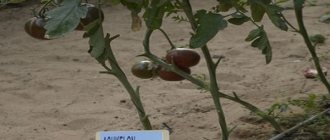Every passionate summer resident and professional farmer knows that correctly bred and proven hybrids are always a winning option.
Shoots of such plants appear evenly and in large numbers, which ensures increased productivity. They benefit more effectively from the conditions they find themselves in, be it climate, soil type or humidity. Hybrids are much more resistant to diseases and pests and are self-pollinating - two more valuable advantages if you grow your vegetables in greenhouses. And the hybrid varieties look much prettier than their “pure” counterparts. However, they must be chosen wisely.
In this article we will give a full description of one of the most interesting tomato hybrids of Russian origin with the enticing name King of the Market. Is this variety really as good as it is called?
Tomato King of the Market - full review of the variety
The King of the Market variety was developed by Russian breeders in the early 2000s. Initially, it was developed for the needs of industrial production, so first of all, the tomato gained popularity in the large market. However, soon its positive qualities were noted by ordinary farmers.
It appealed to many professional gardeners and summer residents, causing them a large number of positive reviews, and the originator - an incentive to select new hybrids specifically for owners of small gardens.
Since the introduction of the first Market King, this series has expanded significantly and now has 13 officially registered representatives. Although the new varieties differ from their ancestor, in general all tomatoes of this variety have similar properties.
Distinctive features
Most varieties of the variety are classified as hybrids for open ground - 9 out of 13 tomatoes of the King of the Market variety are determinate.
The exceptions are four indeterminate varieties : Pink Market King No. 8, Giant King No. 9, Pickling King No. 11 and Honey King No. 12. They are suitable for planting both in open ground and in greenhouses.
Photos of varieties of the King of the Market variety:
In determinate tomatoes of this type, the bush is low-growing and slightly stretches upward. The growth stage quickly ends with a flower cluster. Such a bush grows to a maximum of 100 cm. Indets reach up to 1.5 m in height.
In both subspecies, during growth the bush forms two stems. They grow strong and thick, but, nevertheless, they still need to be tied up due to the abundance and heaviness of the fruit.
According to professional breeders, tomatoes of the King of the Market F1 variety have the following advantages:
- grow well in arid climates;
- tolerate sudden fluctuations in temperature and humidity without problems;
- resistance to the main complex of tomato diseases and cracking;
- rarely become an object of interest for pests;
- uniform and abundant harvest on all bushes;
- suitable for consumption both fresh and processed;
- Thanks to their thick skin, they tolerate transportation and storage well.
Among the disadvantages, gardeners from non-southern regions point out their increased heat-loving nature - such tomatoes germinate more slowly and set trusses in the middle zone, but it is not recommended to grow them in the northern regions.
Many summer residents also find a disadvantage in the fact that “kings” cannot be preserved in their entirety due to their large fruits . However, they are gladly used for drying, barrel or tub salting.
Fruit characteristics and yield
Almost all fruits of the King of the Market variety are visually similar. In appearance, all representatives of this variety are perfectly even and smooth. The taste of the fruit, starting with Market King No. 4, was improved, so later hybrids are distinguished by a sweet taste and aroma, as well as juicy and elastic pulp.
When ripe, tomatoes acquire a bright red color and have a round, slightly elongated shape. Tomatoes of other colors were specially bred in the series - Pink Market King No. 8 and Orange Market King No. 13. Obvious differences in shape are observed in the King of the Market No. 2 and in the King of Salting No. 11 - they have a cylindrical shape, similar to cream.
As for the weight of fruits, on average it varies from 180 to 300 g. The varieties King of the Market No. 7 and King Giant No. 9 stand out from the general picture with fruit weights of 400-600 and 400-1000 g, respectively.
The yield of the Market Kings is average among other hybrids - from 9 to 13 kg per 1 m². The average fruit yield per bush is extremely high – 92%.
Photos of unusual varieties of the King of the Market variety:
General characteristics
Despite the wide variety of tomatoes in the King of the Market series, these hybrids have some features that are common to absolutely all representatives of this group of tomatoes.
- High resistance to most diseases characteristic of nightshades: fusarium, verticillium, alternaria, gray leaf spot, tobacco mosaic virus;
- Tomatoes are also rarely affected by pests;
- The fruits are characterized by long shelf life (up to 1 month or more) and good preservation (they do not crack either on the bushes or after harvesting);
- Tomatoes have dense pulp and smooth, strong skin, which makes them ideal for any preparation;
- The shape of the tomatoes is ideal, with virtually no ribbing.
- High yield of marketable fruits, up to 92%;
- Resistant to temperature changes and other weather conditions that may be unfavorable for tomato development;
- Stable and fairly high yield due to good fruit set, which is practically independent of weather factors.
How to grow seedlings
Tomatoes of this variety are mainly grown in seedlings, unless they are used exclusively for further processing.
Seed preparation
In order not to be upset by empty pots and not to leave free space in the beds, check and select the seeds in advance. The easiest way to do this is to immerse them in a saline solution (1 teaspoon per glass), stir for 1-2 minutes and leave for another 10. Remove the seeds that float to the surface of the water, rinse the rest and dry well in the open air .
Container and soil
Both classic containers and modern small home greenhouses, as well as environmentally friendly peat pots, which are more convenient for further replanting in the ground, are perfect for seedlings. The soil must be slightly loose and well fertilized. As a top dressing, choose regular mineral fertilizers.
Sowing
Plant the seeds to a depth of 2-3 cm by the end of March or beginning of April. Late planting may result in tomatoes not having time to ripen, especially if you chose a mid-season or mid-late variety.
Growing and care
Apply the first bait two weeks after planting; for a successful result, repeat the procedure up to 2-3 times. Loosen and water the soil generously, but do not overdo it. You can also additionally lay mulch on the seedlings in the form of newspapers or used paper, turning it over periodically to avoid debate.
Plant care
The king of the market is a fairly unpretentious hybrid. It is flexible and adapts to almost any conditions. But if you want to get a really good harvest, then you should follow the watering and fertilizing regime, as well as perform agrotechnological techniques (tying, weeding, loosening).
Watering rules
Rules for watering tomato King of the Market:
- Use warm, settled water.
- Watering is carried out at the root. Leaves and inflorescences should not be irrigated.
- On average, one bush requires 5 liters of water. During the flowering period and before fruit formation, the amount of water is increased to 10 liters.
- The frequency of watering depends on weather conditions. Both the top layer of soil should not dry out or become waterlogged. On average, the frequency of watering is 1-2 times a week.
Top dressing
To provide nutrients, the plant is fed with nitrogen fertilizers two weeks after planting and with phosphorus-potassium complexes during flowering and fruiting (once every 2-3 weeks). Tomato also responds well to organic fertilizing (0.5 liters of mullein or bird droppings diluted in 10 liters of water). At the end of July, feeding is stopped so as not to promote the growth of green mass to the detriment of fruit ripening.
Read about the features of applying fertilizers for tomatoes.
Stepping and bush formation
The King of the Market does not require mandatory pinching, but some farmers form a bush with 2 stems, removing unnecessary shoots every 11 days. Without stepsoning, the King of the Market will give a later, but also more abundant harvest.
Regardless of whether you are engaged in the formation of a bush, it needs to be tied up, since most of the hybrids in the series have large fruits, which, combined with high productivity, requires fixing the plant to preserve the tomato. The bush is tied to pegs or a trellis is made. It is better to use synthetic materials for garters (they do not rot and are more durable).
Loosening the soil and weeding
After watering, the soil is loosened to a depth of 4-5 cm. Careful weeding is also necessary: all weeds are removed by the roots to prevent pest infestation. To simplify this work, a tool such as a Fokin flat cutter is used.
Did you know? The Fokina flat cutter is such a popular tool that it is often counterfeited. The original flat cutter has a black blade, and its handle is never painted.
Pests and diseases of the variety
The Market King has excellent immunity against the most common diseases: fusarium, tobacco mosaic, gray rot, late blight. However, improper care can lead to the development of certain diseases and pest damage.
Let's consider the main threats to the health of tomatoes and methods of their treatment and prevention:
- Alternaria blight - a fungal disease that affects the stem, leaves and fruits. The reason for the development is non-compliance with crop rotation and a combination of hot weather with high rainfall. To get rid of Alternaria fungicides “Tattu” and “Antrakol” are used.
- Black spot much more dangerous than Alternaria. It is characterized by the rapid spread of dark spots on the leaves. The leaves fall off, and the fruits rot and do not ripen. If a disease is detected, the affected plant must be removed and burned, and the entire area surrounding it must be treated with Bordeaux mixture. Black spot can be prevented by regular fertilizing with mineral fertilizers, timely weeding, non-thickening of plantings and adherence to crop rotation.
- Medvedka harms tomato roots, it is especially dangerous for young seedlings. Thorough weeding will serve as prevention, and if the mole cricket is already annoying you, the drug “Thunder”, whose granules are laid out in moistened soil to a depth of 3-5 cm, will be a great help.
- To combat Colorado potato beetle, which feeds on tomato leaves, use the chemical preparation “Prestige”, and also dust the plants and soil with sifted ash.
- Netted slug Typically emerges in cold, rainy summers and feeds on tomato foliage, leaving holes and a silvery slimy trail. This is not only unaesthetic, but also entails a slowdown in the growth of tomatoes and the death of flower stalks. In addition, the slug spreads infections and fungi. Slugs are collected by hand and destroyed. “Biological weapons” such as parasitic nematodes are also used. This microorganism is safe for both humans and tomatoes. The nematode is sold packaged in boxes in specialized stores. Another good means of prevention is to plant onions and garlic between rows.
How to grow King of the Market tomatoes
Due to the excellent characteristics and properties of the King of the Market hybrid, anyone, even a novice gardener, can grow it if he follows simple rules for planting and care.
Landing in the ground
It is best to plant seedlings in the ground towards the end of spring - beginning of summer, when the soil no longer freezes at night. From 3 to 5 plants are planted per square meter. It is better to find out the planting interval from the recommendations on the seed packaging of the King of the Market variety you have chosen. Usually it is 40 by 50-70 cm.
Care
Hybrids of this variety do not like heavy watering, but you should not overdry the soil even in temperate climate zones. Weed and loosen the soil as necessary, remove excess shoots and tie up the stems.
In addition, the variety readily responds to complex feeding. With this care, bushes are formed more neatly and give a generous harvest. The taste is also noticeably improved.
Features of cultivation and possible difficulties
To form beautiful tomato bushes of this wonderful variety, immediately after the first flowers appear on the first formed tomato cluster and the formation of two stepsons, break off the least powerful of them with your hands. Plant the plant every 10-12 days in warm sunny weather in the morning or afternoon.
If you don’t have enough bushes, you can grow tomatoes with two stems. Then just leave the stepson above the first brush, then tie it up separately and grow it further, carefully monitoring the condition of the bush.
Features of the formation of determinate type tomato bushes:
How to form tomato bushes Part 1 - Formation of determinate type tomatoes.
Diseases and pests
Please note that the normal color of ripening fruits is light green without stripes or spots. If yours is different, check your plants for diseases or pests. Typical diseases for the King of the Market are Alternaria and bacterial spot. For prevention, feed the bushes with fertilizers containing copper and nitrogen.
No matter how good this tomato variety is, pests will still want to flock to the fragrant smell of the fruit. Mole crickets, slugs or Colorado potato beetles are often spotted near the Market King.
Purchase the necessary medications for the Colorado potato beetle and mole crickets in advance in case they suddenly appear. At the first sign of slugs, spray the plants with a solution containing black pepper or mustard (1 tbsp per 1 m²). If you notice a mole cricket, you need to thoroughly weed the ground before spraying.
Diseases and pests
The queen of the market is a type of tomato that is resistant to various diseases, but can also suffer from infections. In the vast majority of cases, the bush suffers from diseases such as Alternaria.
To combat this, you can use drugs such as:
- Antracol;
- Tattoo;
- Consento.
Another problem that besets tomatoes of the described variety is bacterial spotting. If bushes suffering from the disease are found, they should be destroyed immediately; the remaining plants are urgently treated with Bordeaux mixture. Don’t forget about the soil, disinfection of which is the key to stopping the spread of the disease.
The king of the market is a variety that mainly grows in open ground. This has one drawback: it is difficult to control the emergence of pests that can destroy the plant. For example, among the frequently encountered “neighbors” of the tomato are mole crickets and slugs.
You can fight slugs using folk remedies. Preparing the solution is simple, as you need ingredients that are found in every home:
- hot peppers;
- dry mustard;
- water.
Having mixed all the components in equal proportions, you should water the area occupied by slugs at the rate of 1 tablespoon of solution per square meter.
You can also deal with a mole cricket. Careful weeding of tomato beds and treatment with a preparation called “Thunder” will help solve this problem.
Plant feeding should be regular. The variety best accepts preparations containing copper and nitrogen. Following simple recommendations for caring for tomatoes will allow you to get bright, tasty tomatoes.
The nuances of growing in open ground and in a greenhouse
Growing tomatoes outdoors is much more dangerous in terms of the likelihood of pests. Therefore, do not forget to inspect them and the soil surrounding the plants often.
When growing in greenhouses, maintain the correct microclimate and remember that this variety is not accustomed to excessive watering and high humidity. Also leave enough free space for the Market Kings in a well-lit area of the greenhouse - this will make the bushes more spreading and able to produce more fruit.
Important! Do not leave the greenhouse closed in summer in bright sun or heat - tomatoes must be ventilated constantly. The doors to the greenhouse are closed only in rainy weather or when the air temperature is below 12 degrees.
Growing from seeds to seedlings at home
When buying seedlings on hand, there is no guarantee that it will be the King of the Early, so you can try to grow the seedlings yourself.
Seed preparation
First of all, it is important to choose seeds that are more than two years old. Seed preparation includes several stages:
Seed preparation includes several stages:
- soaking in a weak solution of potassium permanganate for 30 minutes;
- rinsing under running water;
- keeping in a growth stimulator for 12 hours;
- hardening in the refrigerator - overnight;
- drying.
Did you know? It is believed that tomatoes come from Peru, or more precisely, from the coastal strip between northern Chile and Ecuador. This culture was cultivated there long before the arrival of Europeans.
Seed planting process
Prepared seed can be sown in early March in cassettes, peat tablets or special boxes. The earth is pre-moistened. It is convenient to take the seeds with a toothpick or use a hand seeder. When sowing, 3 pieces are placed in containers or tablets. into one cell. They are placed in boxes at a distance of 3 cm, with a distance of 4 cm between rows. Sprinkle them with earth no more than 2 cm and moisten them with a spray bottle. The containers are covered with a lid, glass or film and placed in a warm and dark place.
Seedling care
After thin threads of seedlings appear, the seedlings are placed closer to the light and the covering is removed. You need to water as the top layer of soil dries, making sure that the drops do not fall on the leaves. Plants are turned towards the light every two days so that they grow evenly. At the stage of two true leaves, the seedlings dive. 2 weeks after picking, you can start feeding fertilizers for seedlings. Before planting in open ground, there can be three feedings.
When the tomatoes grow to 15 cm, they begin to harden off before planting outside. Start doing this for 30 minutes at a temperature not lower than +15°C. To do this, the containers are placed on the balcony or veranda in the evening. The time is increasing every day. Also, tomatoes are gradually accustomed to sunlight, removing shading after 16 hours.
Find out also about the best varieties of tomatoes that are resistant to late blight.
Immediately before planting, plants can be treated with copper sulfate to prevent disease.
Transplanting seedlings into the ground
Tomatoes are planted in the greenhouse when they reach 20 cm in height. This is approximately the beginning of May. It’s too early to plant in open ground; you’ll have to wait another three weeks. Our grandmothers were guided by the 20th of May, when there was no longer a risk of frost returning.
Planting is carried out on a cloudy day, preferably rainy. In the prepared area, holes are made for half a shovel at the rate of 6 pieces per m². This variety should not be placed more densely, as it produces many side branches that will interfere with walking between the bushes. Or you will have to regularly remove excess parts. The distance between rows should be about a meter.
1 liter of water is poured into each hole and a handful of ash is placed. You can add onion peels. The seedlings are carefully removed from the containers, being careful not to damage the roots. The longest central root is cut in half. The tomato is lowered into the hole, sprinkled with soil and compacted. When all the plants are planted, each is watered with water heated in the sun. You can mulch the ground around with peat or sawdust to retain moisture well.
Important! As a result of heat treatment, the beneficial properties of tomatoes only improve.
Harvesting and application
Early and mid-ripening varieties of King of the Market tomatoes are harvested as early as July-August, depending on the growing region and the type of tomato. Productivity is maintained until autumn frosts.
Market King tomatoes starting from No. 5 are best suited for fresh consumption in salads. They produce delicious tomato juice, in which both sweetness and sourness are evenly felt. Tomatoes are also dried, salted and pickled in barrels.
Important! As with other hybrids, it is better not to use seeds from already grown King of the Market tomatoes for planting. Their yield and other beneficial properties will drop noticeably.
Useful video
We invite you to familiarize yourself with the tomato varieties that are also recommended to be grown outdoors, like the “King of the Market” tomato:
And in the table below you will find links to articles about tomatoes of various ripening periods that may be useful to you:
| Super early | Mid-season | Mid-early |
| White filling | Black Moor | Khlynovsky F1 |
| Moscow stars | Tsar Peter | One hundred poods |
| Room surprise | Alpatieva 905 a | Orange Giant |
| Aurora F1 | Favorite F1 | Sugar Giant |
| Severenok F1 | La La Fa F1 | Rosaliza F1 |
| Katyusha | Right size | Em Champion |
| Labrador | Dimensionless | Sultan F1 |
Other varieties with similar names
There are several varieties on the market with similar names, with which the Market King is often confused if they are not familiar enough with it. However, other types of tomatoes are in no way similar to the “true” King.
For example, the Koroleva market variety was developed and tested in cold Siberian conditions. The average bush of this hybrid is twice as tall as the King of the Market. Its yield reaches 18 kg per 1 m², and the fruits themselves are large, flattened and weigh up to 900 g. This is an excellent replacement for the King of the Market for the northern regions of the country.
Other “royal” tomatoes are the King of Siberia, orange in color, oblong in shape with a fruit weight of up to 700 g. Unlike the King of the Market, they are resistant to Alternaria.
Photo of tomato varieties Golden King, Queen of the Market and King of Siberia:
Features of growing tomatoes King of Siberia, planting and care
It is recommended to sow the seeds of this tomato variety for seedlings 60-65 days before the intended planting in the ground. Picking of seedlings is carried out at the stage of 2 true leaves. When planting seedlings in a permanent place per 1 sq. No more than 4 plants are placed per meter of plot.
Further care for tomatoes consists of timely watering, weed removal, pinching, fertilizing and preventive measures to protect the crop from diseases and pests.
If you grew King of Siberia tomatoes, please write whether you liked them or not. What was the yield and taste of the fruits like under your climatic conditions? How do you rate the disease resistance of this variety? Briefly describe the advantages and disadvantages of this tomato in your opinion. If possible, attach a photo of the entire bush or individual fruits you grew to your comment. Thank you!
Your reviews of the King of Siberia tomato and additions to the description will help many gardeners evaluate it more objectively and decide whether it is worth planting or not.
Farmer reviews
The King of the Market tomato variety still collects exclusively positive reviews from summer residents, owners of their own personal plots and professional farmers. Many note its high yield, but in the middle zone it is recommended to additionally fertilize and treat it against late blight.
Here are some of the reviews:
Alexander Smirnov, Sochi: “I live in sunny Sochi, I’ve known about these tomatoes for a long time. I usually plant 2-3 species from this series. I prefer Market King #5 for juice, Pickle King for twists, and Pink Market King for salads. The king of pickles is sour, the rest are sweeter. The tomatoes do not crack, are beautiful and without blemishes. Sometimes when I have nowhere to put them and my daughter comes, I give them to her in boxes. Or I sell it on the market. They are among the first to sell out, there is great demand.”
Olga Vershinina, Penza: “Giant King No. 9 has become my favorite variety of large-fruited tomatoes. It has amazing yield, about 1.5-2 times better than the varieties that I sowed before. I have been planting them for the second year in ordinary plastic pots. I keep it under a phytolamp, water it once a week and feed it - the sprouts sprout very well. Then in the second week of June I transplant them to the beds. I plant in a square-cluster method, so I don’t have to water it often. They still grow and produce a lot of delicious tomatoes. Wonderful variety! "
Tatyana Savenko, Kirov: “I have two greenhouses, every year I look for new tasty varieties of tomatoes. I really like to eat them fresh. That year I chose the Orange King of the Market. These tomatoes are tasty, dense, super-yielding, and most importantly - hardy and do not get sick! This summer I’ll try to plant it in open ground, I think the result will be just as good.”
Vladimir Grachev, Magnitogorsk: “Our summer is not particularly warm, the average temperature is about 20. I planted the Honey King tomato in a greenhouse, the seedlings were vigorous, almost all the seeds appeared to have sprouted. At first the bushes grew slowly, but then they became stronger. The taste was truly honey, so sweet. I used all the juice for spinning - I made tomatoes in my own juice. I would rather tighten these tomatoes, but they turn out to be very large, they don’t even fit in a three-liter container.”
Advantages and disadvantages
The undoubted advantages of the variety include the following qualities:
- large-fruited - tomatoes reach a weight of up to 250 g or more;
- excellent yield indicators - up to 18 kg of selected fruits are harvested from 1 m2 of greenhouse area;
- high marketability;
- transportability, the ability to transport even long distances;
- long storage period of the harvested crop – up to 2 months;
- plant resistance to major diseases.
The advantages of tomatoes include good ripening ability. If necessary, tomatoes can be picked green; they will gradually ripen.
If we talk about the disadvantages, among the disadvantages of this tomato we can note the need for staking tall bushes and regular pinching.
What qualities do fruits have?
The fruits are valued for their taste
Undoubtedly, every gardener is interested not only in how intensively he will have to care for the crop that he is going to grow, but also what characteristics his harvest will have. This allows you to determine the profitability of planting and further caring for the plant. This is especially important when tomatoes are grown for the purpose of subsequent sale.
According to experts, experienced gardeners and ordinary consumers, growing the King of the Market tomato on your own plot is completely justified. This process is justified not only by ease of maintenance, but also by the following product indicators:
- One fruit can weigh up to 300 g.
- In appearance, the tomatoes are round, slightly oblong.
- The surface of the tomato is smooth.
- The fruits are resistant to cracking.
Ripe tomatoes turn red. Tomato skin has a higher density. This allows the pulp not to be damaged during storage or transportation. This property is also appreciated by breeders and consumers.
The taste characteristics of the King of the Market tomato indicate that the fruits of this variety are simply ideal for fresh consumption. Tasty and sweet-tasting tomatoes are added to salads, vegetable dishes, and various snacks. These tomatoes are also actively used for making juice. The large size of the fruit becomes an obstacle to their canning. However, inventive housewives have found a way out - the King of the Market tomatoes, dried or pickled in barrels, perfectly dilute the winter diet of many families.
Features of agricultural technology
The seedling period is present, but not required. Depending on the purpose of the future fruits, the seeds are either sown directly in unprotected soil or seedlings are grown. In the garden you will definitely need to organize a support system.
Advice. Tomatoes for processing can be grown immediately on the plot; a juicier and larger-fruited harvest is obtained by cultivating seedlings; such tomatoes go into salad.
The southern regions are considered preferable for breeding the King, but many agronomists successfully grow the hybrid in greenhouses in the middle zone. However, there is less resistance to disease and a decrease in product quality.
The crop prefers complex fertilizers. The most common care actions will be pinching and fighting Alternaria. Special solutions (for example, Antrakol) will help quickly. Regular preventative tillage will help reduce risks to a minimum.
Unfortunately for gardeners, they are not the only connoisseurs of succulent crops. The Colorado potato beetle, in the company of mole crickets and slugs, poses a serious threat to garden beds. Spraying with garlic or pepper water and frequent weeding will help you cope with pests.
The series is extensive, but the tomatoes are united by the juiciness and sweetness of the fruit
Experienced agronomists should pay attention to the Giant and Honey hybrids. And the first samples of the series are suitable for pickling
Pros and cons of the variety
The advantages of the Market King include:
- resistance to hot arid climates;
- immunity against pathogenic microorganisms that cause diseases;
- good yield;
- excellent taste;
- excellent presentation;
- transportability;
- long-term preservation.
This tomato does not need to be tied up.
But there are also minor drawbacks. The main one is the clearly defined regionalization of the hybrid. When grown outside of the southern regions, the crop loses yield and other qualities. A relative disadvantage is the large fruit, which imposes certain restrictions on the types of winter harvesting.
Description of the variety
Plants of the “King of Kings” variety are indeterminate tall and highly branched shrubs, the growth of which must be limited by pinching the main stem to a maximum of 180 cm. The level of foliage is average, brushes begin to form after the ninth leaf, then every three to four.
Did you know? Peru is considered the birthplace of tomatoes, where this crop was grown long before the arrival of Europeans. Further (about 9 thousand years ago), tomato bushes began to be cultivated by tribes of local Indians in the rest of South America.
The advantages of the hybrid “King of Kings” include:
- high level of productivity;
- beautiful, very large fruits;
- excellent taste;
- resistance to certain diseases;
- good transportability;
- long shelf life (up to 3 weeks).
- expensive cost of the original packaging with seeds;
- inability to use fruits for pickling or preservation.
A distinctive feature of the variety is the impossibility of independent seed propagation - to obtain a similar plant with the same characteristics next year, the farmer should purchase new packaged seedlings in the store.
Diseases and pests
The hybrid is resistant to most tomato diseases.
If the watering regime is not followed, or insufficient fertilizing, it can sometimes be affected by late blight and blossom end rot. To prevent diseases, it is recommended to treat the bushes with Bordeaux mixture. Infection with blossom end rot is usually the result of irregular watering, a violation of the air humidity in the greenhouse, or a lack of calcium. Therefore, the bushes must be sprayed with a solution of calcium nitrate.
Tomatoes are loved by pests such as aphids and whiteflies. Regular treatment of the plant with a soap solution helps against aphids.
To combat whiteflies, special sticky tapes or fumigators are used. Insecticides help in the fight against insects
Their use must be approached with caution, strictly follow the manufacturer's instructions, and process before the period of active flowering.
Other interesting tomato varieties:
- Tomato variety Black Prince
- Tomato variety One Hundred Poods
- Tomato variety Flyashen
- Tomato variety Vova Putin
- Tomato variety Banana legs
Disinfection of soil and greenhouses before planting tomatoes helps combat pests and diseases.
The structures are treated with disinfecting solutions, and sulfur bombs are used. It is recommended to remove the top layer of soil 20 cm thick. It may contain larvae, viruses, and spores of fungal diseases.
The rest of the soil is watered with a solution of copper sulfate or potassium permanganate. Digging up the soil annually helps control the number of pests.
To reduce the likelihood of tomatoes becoming infected with diseases of nightshade crops, it is worth following simple rules of crop rotation on the site. Do not grow tomatoes in the same place for several years in a row.
Avoid proximity to eggplants, potatoes, peppers. All nightshade crops are susceptible to the same diseases and pests. The best neighbors and predecessors are zucchini, cucumbers, legumes, cabbage, and onions.
